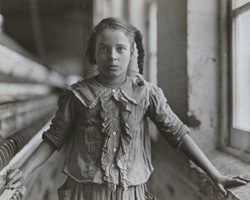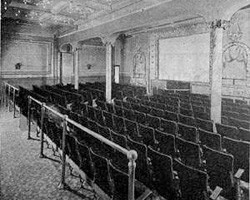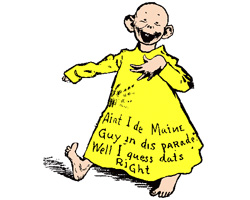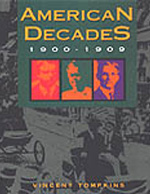The 1900s
Introduction
Immigration and industry both boomed in the United States in the 1900s. These immigrants, seeking better opportunities in the U.S., found hazardous working conditions in factories and squalid living conditions in tenements. Big business led to big questions for many journalists of the 1900s. From Upton Sinclair's book, The Jungle to Ida Tarbell's investigation of John D. Rockefeller, newspapers and magazines in the 1900s were full of exposés. President Theodore Roosevelt described these journalists as muckrakers.
In the quest for increased readership, newspaper editors began to publish sensational headlines and lurid stories. The age of yellow journalism was in full flower.
International communication was made advanced by Guglielmo Marconi, who sent the first radio transmission across the Atlantic Ocean. Thomas Edison harnessed electricity and started one of the first movie companies. His execution movie told the tale of President William McKinley's assassin's death.
- The 20th century begins (video)
- What there wasn't in 1900 (video)
Journalists and media personalities
Joseph Pulitzer

A Hungarian immigrant with few resources, Pulitzer rose to purchase the struggling New York World newspaper in 1883 after many successes in St. Louis. Pulitzer used his newspapers to crusade for the rights of immigrants, the poor and the working class. Sensational headlines such as "Baptized in Blood" competed with those of the New York Journal owned by William Randolph Hearst.
- Theodore Roosevelt's libel lawsuit against Pulitzer and The New York World (video)
- Pulitzer's immigrant audience (video)
- Pultizer and the Statue of Liberty (video)
- The rise of the New York Journal, the downfall of Pulitzer's health (video)
- Pulitzer's lifestyle (video)
- Cuba, the U. S. S. Maine and yellow journalism (video)
- Joseph Pulitzer and The Pulitzer Prizes -- The Pulitzer Prizes (web site)
William Randolph Hearst

William Randolph Hearst, the only son from a rich family, took control of his father's newspaper in 1887 after an unsuccessful stint at Harvard. Hearst became a major competitor of Joseph Pulitzer when he purchased The New York Journal in 1895. Under Hearst's direction, the paper fanned the flames of war, urging it's readers to "Remember the Maine", a U.S. navy ship that exploded mysteriously in Cuba. Hearst's efforts contributed to the start of the Spanish-American War. Hearst is quoted as saying, "War makes for great circulation." Hearst used the expansion of his newspaper chain to further his political ambitions, though without the same level of success as his media empire.
R. F. Outcault

Creator of The Yellow Kid and Buster Brown comics. The Yellow Kid would symbolize the circulation wars between Pulitzer and Hearst; the comic appeared in both newspapers simultaneously. The term "yellow journalism" derives from his popular comic strip. Outcault's creations also generated the first comic merchandising; key rings, statues and other Yellow Kid paraphernalia predated Happy Meals by decades.
- The Yellow Kid (video)
- R. F. Outcault Society's Yellow Kid (web site)
Lincoln Steffens

New York Post reporter and managing editor of McClure's Magazine. Steffens wrote a series of articles that exposed corruption in the local governments of Chicago, Minneapolis, Pittsburgh, St. Louis, Philadelphia and New York City; later collected in the book The Shame of the Cities (1904). The Struggle for Self-Government (1906) told of investigations of state politicians. He joined other muckrakers like Tarbell and Ray Stannard Baker to form the American Magazine.
Ida Tarbell

As a teenager, Ida Tarbell witnessed first hand the efforts of the Standard Oil Company's efforts to monopolize oil production in Pennsylvania. Tarbell wrote The History of the Standard Oil Company articles in McClure's Magazine criticizing the business practices of Standard Oil and its president, John D. Rockefeller. Rockefeller responded to these attacks by describing her as "Miss Tarbarrel".
Upton Sinclair

A muckraker and novelist known for his best seller The Jungle, first serialized in 1905 by the socialist journal of tiny Girard, Kansas, Appeal to Reason. Upton Sinclair's classic book described the unsanitary practices of a Chicago meat packing company and led to the passage of the Pure Food and Drugs Act (1906) and the Meat Inspection Act (1906).
"There was never the least attention paid to what was cut up for sausage; there would come all the way back from Europe old sausage that had been rejected, and that was moldy and white - it would be dosed with borax and glycerin, and dumped into the hoppers, and made over again for home consumption."
-- excerpt from The Jungle
Ray Stannard Baker

A muckraker on the staff of McClure's Magazine, Ray Stannard Baker joined Lincoln Steffens, Ida Tarbell, William Allen White and others to found American Magazine in 1906. Baker's articles investigated labor relations and race relations; the latter were collected together in Following the Color Line, illuminating Jim Crow laws, lynching, and poverty. Baker later served as press secretary to President Woodrow Wilson during the Paris Peace Treaty, and wrote a multi-volume biography of Wilson.
"But the mob wasn't through with its work. Easy people imagine that, having hanged a Negro, the mob goes quietly about its business; but that is never the way of the mob. Once released, the spirit of anarchy spreads and spreads, not subsiding until it has accomplished its full measure of evil.
-- excerpt from an article entitled What is Lynching?
Nellie Bly

A pseudonym for Elizabeth Cochrane, Nelly Bly is known for numerous journalistic and business accomplishments. As a reporter, Bly pioneered techniques in investigative journalism by faking her own insanity in order to go undercover in New York's insane asylum on Blackwell's Island. During her lifetime, Bly also circumnavigated the globe in 72 days, managed two multi-million dollar companies at the same time, and was the first female correspondent to cover the eastern front during World War I.
- Nelly Bly -- National Woman's Hall of Fame (web site)
- Nellie Bly (video)
Political scene

President Theodore "Teddy" Roosevelt.
Theodore Roosevelt was the first U.S. president to have his career and life captured on film. When President William McKinley was assassinated at the Pan-American Exposition in Buffalo in 1901, Vice-President Roosevelt took office.
Known for his "big stick" policy in international affairs, Roosevelt has been quoted saying, "Speak softly and carry a big stick; you will go far."
After re-election in 1905, Roosevelt worked to bring a peace settlement to the Russo-Japanese War. Roosevelt also acquired the right for the U.S. to build a canal in Panama and visited the country, the first time a U.S. president had ever visited a foreign nation.
Roosevelt coined the phrase "muckraker" to describe investigative journalists who fueled the progressive era crusades. He also sued Joseph Pulitzer and the New York World for libel following the publication of an unfavorable editorial regarding the involvement of the United States in the Panamanian Revolution. The case was dismissed.
- Theodore Roosevelt: His Life and Times on Film -- The Library of Congress (web site)
- Theodore Roosevelt becomes president (video)
- Theodore Roosevelt's image (video)
- Theodore Roosevelt conservation policies (video)
- Theodore Roosevelt invades Panama (video)
- Theodore Roosevelt, the Panama Canal, and scandal (video)
- Theodore Roosevelt sues Pulitzer and the New York World (video)
Social climate

Child labor was still a common practice at the beginning of the 20th century.
The turn of the century also marked the dawn of many new technologies. Inventors, scientists and industrialists were busy around the turn of the century developing inventions. Thomas Edison created moving pictures and harnessed electricity while the Wright Brothers spread their wings.
At the same time, millions of immigrants arrived on U.S. soil, mostly from southern and eastern Europe. Though most were farmers, a majority would only find factory jobs in eastern U.S. cities.
Technological breakthroughs in transportation, communication, mechanization and science fostered an industrialized society. Corporate consolidations ruled the day, and the working conditions of men, women and children as laborers were harsh and brutal. Boys as young as 12 years old commonly worked in dangerous conditions in the coal mining industry.
Races relations degraded following the Plessy vs. Ferguson of 1896 decision that legalized segregation. Jim Crow laws also marginalized African Americans, preventing them from voting, while also turning a blind eye to white violence.
- New immigration (video)
- Labor unrest (video)
- Race relations (video)
- The New York World crusade to help children (video)
- Appeal to Reason --the rise of socialism in the United States (video)

The first nickelodeon theater, Pittsburgh Pennsylvania
One of the new media technologies — new storefront theaters dubbed nickelodeons — succeeded wildly as an innovative form of entertainment. Appearing first in 1905, nickelodeons featured movie shows all day long, in contrast to the vaudeville theaters. Actuality film — reenactments of media events and the forerunners of newsreels — proved to be very popular with the new audiences.
The first nickelodeon was built in Pittsburgh in June 1905, and others quickly flourished around the country. By 1908, approximately 8,000 nickelodeons in the U.S. allowed people to stop in almost anytime to enjoy the frequent showings. Later, bigger theaters would be built allowing larger audiences to see longer films projected on a bigger screens.
- Nickelodeons (video)
Media moments
1900 –Thomas Edison's execution movie

An actuality -- a short non-fiction film -- of the execution of the assassin of McKinley carried out from the description of an eyewitness. Motion pictures became popular, first as single-viewer kinetoscopes, then as films projected for mass audiences. Edison's company, Thomas A. Edison, Inc., produced films showing famous people, news events, disasters, and everyday people doing everyday activities.
- History of Edison's Motion Pictures -- Library of Congress (web site)
- McKinley's death and his assassin (video)
- Thomas Edison's silent 'newsreel' of the execution (video)
- Martyred presidents (silent video)
1901: Trans-Atlantic radio transmission

Guglielmo Marconi, the "father of radio", took a simple interest in "Hertzian Waves" and invented one of the most important new media's of the new century. Having first experimented with radio transmissions in the attic of his parent's home, Marconi traveled to England in a search for investors. There, he founded the Wireless Telegraph and Signal Company Limited which began building radio equipment in 1889. To publicize the new invention, Marconi gave numerous demonstration, including one to Queen Victoria. In 1901, Marconi successfully transmitted the first radio signals across the Atlantic Ocean.
1903 – The Great Train Robbery

One of Edison's most famous 'actualities', this eight-minute action film depicted a robbery by Butch Cassidy. Enormously popular, it is one of the first films to tell a coherent story. Later, when the audiences became bored with "real" events, Edison and his company began producing action, drama and comedic films.
- The Great Train Robbery (video)
April 18, 1906 – San Francisco's devastation captured on film

Only days after and earthquake and fire destroyed much of San Francisco, the first "newsreels" were there to capture the devastation. This disaster would be the first major event of its kind to be captured for the viewing audiences around the United States and the world, though much the "ongoing destruction" was staged for the cameras.
1907 – First Trial of the Century

Girl meets boy: Evelyn Nesbit, a 16-year-old showgirl, enjoyed some, but not all of the affections of Standford White, the famous New York architect who designed Madison Square Garden. Boy meets girl: Henry K. Thaw, an "eccentric" millionaire met and eventually married Evelyn, but grew to hate her former seducer, White. Boy flies into a jealous rage and kills wife's ex-lover: Thaw shot White as he entertained on the roof garden of Madison Square Garden and was immediately arrested. Press has field day: supposedly even President Theodore Roosevelt followed the coverage in the newspapers. Justice served?: Thaw was eventually freed and immediately divorced Evelyn.
1908: – Electric Light

Thomas Edison — having already conceived, built and marketed an amazing number of devices like the motion picture camera — invents the electric light. Now taken for granted, the electric light changes society. It became much easier for people to to stay up late in the evening and enjoy more social activities. The night was somewhat tamed by the spread of street lamps, headlights and illuminated signs. The stars disappear in urban areas, and life becomes a 24-hour experience with the simple flick of a switch.
Trends in journalism

"The Yellow Kid"
The era before and during the 1900s is known as the age of yellow journalism, when sensational headlines and lurid stories were the norm. It was also a time when many determined journalists exposed corruption in government, the unfair treatment of factory workers, and the privileges of the upper class.
McClure's Magazine, owned by Samuel McClure and originally established as a general interest magazine, moved into the business of muckraking, exposing the faults of expansion and industrialization. These two trends — yellow journalism and muckraking — helped newspapers and magazines become the dominant form of mass media.
- The Yellow Kid, Pulitzer and Hearst (video)
- Muckrakers -- Spartacus Educational (web site)
- Muckrakers (video)
- Muckraking (video)

The USS Maine, shortly after it had exploded and sunk.
Newspaper publishers Hearst of The New York Journal and Pulitzer of The New York World were in a circulation war fighting for the same new target audience – immigrants, who were still pouring in to the New World from Europe. One of the most memorable stories from the era, the sinking of the U.S.S. Maine, would help to propel the United States to war with Spain.
Advertising grew and promoted a culture of consumption. Magazines such as Call's Magazine and The Saturday Evening Post took advantage of advertising to increase their circulation and still keep subscription prices low.
General interest and ladies magazines also flourished. Magazines such as Good Housekeeping and Vogue began targeting niche markets: homemakers and fashion-oriented women. Between 1890 and 1905 the circulation of monthly periodicals went from 18 million to 64 million.

